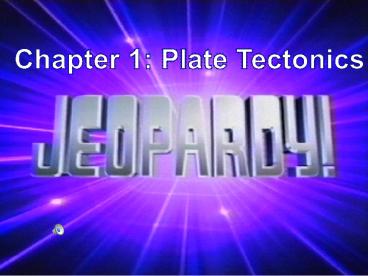Chapter 1: Plate Tectonics - PowerPoint PPT Presentation
1 / 22
Title:
Chapter 1: Plate Tectonics
Description:
Continental Drift Theory This supercontinent began splitting 200 million years ago. Pangaea What three pieces of evidence did Alfred Wegener use to support his ... – PowerPoint PPT presentation
Number of Views:143
Avg rating:3.0/5.0
Title: Chapter 1: Plate Tectonics
1
Chapter 1 Plate Tectonics
2
Chapter 1 Plate Tectonics
Earths Layers Continents Changing Position Over Time Plates Moving Apart Plates Coming Together
100 100 100 100
200 200 200 200
300 300 300 300
400 400 400 400
500 500 500 500
3
This is a solid sphere of metal found in the
center of the Earth. It is mainly made up of
nickel and iron.
The Inner Core
4
The layer of the Earth made up of the crust and
rigid rock of the upper mantle
Lithosphere
5
Although the word asthenosphere comes from the
Greek word asthenes, meaning weak, it is not
actually weak. How can it be characterized?
layer of hotter, softer rock in the upper mantle.
Solid lithosphere rests on it. Hot tar.
6
Most large tectonic plates include two types of
crust. What are these types of crust?
Continental Oceanic
7
To explore the interior of the Earth, what must
scientists study?
They must study the energy from earthquakes or
underground explosions.
8
Alfred Wegener proposed this hypothesis to help
explain Earths continents moving over time.
Continental Drift Theory
9
This supercontinent began splitting 200 million
years ago.
Pangaea
10
What three pieces of evidence did Alfred Wegener
use to support his hypothesis on the continents
moving? And provide detail to at least one.
Fossils- ancient reptile Mesosaurus had been
discovered in South America and western Africa.
Not found anywhere else. Climate- Greenland had
once been near the equator and slowly moved to
the Arctic circle. Geology- best evidence came
from finding a type of rock that was in Brazil
matched rock found in western Africa.
11
Huge underwater mountain ranges that circle the
Earth like the seams of a baseball. They are also
formed from divergent boundaries.
Mid-Ocean Ridges
12
How does the age of the sea floor show that
plates are moving?
Rock is youngest near the ridge, and older
farther away. Showing that older rock was carried
away from the ridge some time ago.
13
This is a boundary where plates are moving apart.
What is the name of this boundary and where are
most of them found?
Divergent Boundaryin the ocean
14
True or False. Mid-ocean ridges are the longest
chain of mountains on Earth.
TrueMid-Atlantic Ridge is the longest.
15
What is a hot spot?
an area where a column of hot material rises from
deep within a planets mantle and heats up the
lithosphere above it, often causing volcanic
activity at the surface.
16
Suppose a magnetic reversal occurred today. How
would new rocks at mid-ocean ridges differ from
the rocks that formed last year?
The magnetic minerals in the new rocks would be
aligned in the opposite direction.
17
Name and describe the three types of plate
movement.
- Divergentmoving apart
- Convergentpushing together/colliding
- Transformscraping past each other
18
This is the process in which one plate sinks
beneath another.
Subduction
19
True or False. Major geologic events occur at all
three types of boundaries.
True.
20
These are like deep canyons that form as the
ocean floor sinks.
Deep Ocean Trenches
21
There are 3 types of convergent boundaries.
Please list all three and describe them briefly.
Continental-continental collision two plates
carrying continental crust push
together Oceanic-Oceanic subduction one plate
w/oceanic crust sinks Oceanic-Continental
Subduction occurs where crust sinks under
continental crust.
22
Please give an example of a transform boundary.
San Adreas Faultthe Pacific plate and the North
American plate are scraping past each other along
the San Andreas Fault. Crust is not being formed
or destroyed.































